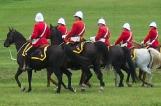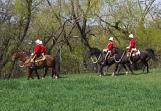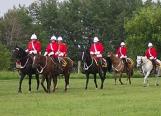14
The Desolate Land16
A smaller and somewhat healthier group continued northwest now to Fort Carlton, over mostly barren land.The lack of food and water was a worry to Inspector Jarvis. "After leaving Fort Ellice I found the pasture and water so bad that I had great difficulty in procuring enough to keep life in the horses and oxen," he wrote in his official report.
"After crossing the South Saskatchewan the pasture improved, and I intended resting the animals for some days, but, as we were overtaken by a severe store, I hurried on the Carlton in hope of saving the horses."
No horses were lost in this eight week portion of the march.
17
Horse Problems19
After just a week of rest in Fort Carlton, A Division was on the move again. It was September, and they were running out of time.Inspector Jarvis was, however, able to purchase grain for the animals. They now enjoyed more food and water for both horses and men, but they still had difficulty moving faster.
Steel wrote: "The country through which we went was a good stock country, but we found the cart trail very rough with roots and stones, and the horses were now beginning to show signs of the long march without grain."
Things did not improve, a little later on the trail, Steel wrote: "Heavy rains had fallen, reducing the trails to a deplorable state, and the poor horses in the waggons staggered along with marvelous pluck. They suffered much more than the oxen, and, as the nights became colder, when they lay down to rest the unfortunate brutes became so stiff that they could not rise without help, and I had to call the men up many times during the night to lift them by main force and rub their stiffened limbs to restore the circulation. To add to our troubles, some of the teams would be hours behind the leaders, and we who were in the rear with the cattle and worn-out horses, had to stay and help them along. Axes and spades were in constant demand to repair the numerous bad spots on the trail, long stretches of which were under water."
21
Arriving at Victoria on Oct. 19, the small force readied themselves for the last leg of the journey to Edmonton. The cows, calves and weak oxen were left there for the winter under the care of a settler, and what remained of the force heading out into the growing cold."Our progress from here to Edmonton and slow and the going very difficult," Steele wrote. "Our loose horses very often fell, and one fine animal being lifted bodily by Carr, the shoeingsmith, and myself at least a dozen times by means of a pole. The other horses had to be helped along in the same manner."
On Oct. 26 they reached the Sturgeon Creek, just across the North Saskatchewan River from where they will later build Fort Saskatchewan. With Edmonton almost in sight Jarvis urged the men to hurry. But it was not to be. "The trail was worse than any we had encountered," Steele wrote. "It was knee-deep in black mud, sloughs crossing it every few hundred yards, and the waggons had to be unloaded and dragged through them by hand."
Exhausted, the group stops at 5 a.m. near Rat Creek, just four miles from their goal. Three hours later they move on and on Oct. 27 they finally reach Fort Edmonton.
In his report of the march, Jarvis praises the "perfect conduct of the men," and singles out Constable Labell and Sergeant-Major Steele. "S. M. Steele has been undeviating in his efforts to assist me, and he has also done the manual labor of at least two men."


